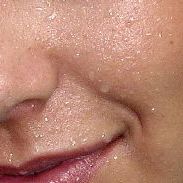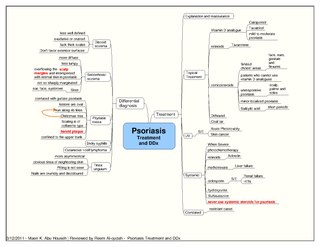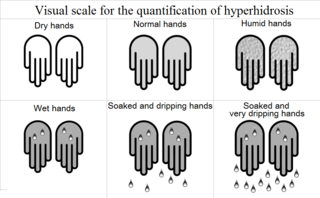
Perspiration, also known as sweat, is the fluid secreted by sweat glands in the skin of mammals.
Iontophoresis is a process of transdermal drug delivery by use of a voltage gradient on the skin. Molecules are transported across the stratum corneum by electrophoresis and electroosmosis and the electric field can also increase the permeability of the skin. These phenomena, directly and indirectly, constitute active transport of matter due to an applied electric current. The transport is measured in units of chemical flux, commonly μmol/(cm2×hour). Iontophoresis has experimental, therapeutic and diagnostic applications.

Hyperhidrosis is a medical condition in which a person exhibits excessive sweating, more than is required for the regulation of body temperature. Although it is primarily a physical burden, hyperhidrosis can deteriorate the quality of life of the people who are affected from a psychological, emotional, and social perspective. In fact, hyperhidrosis almost always leads to psychological as well as physical and social consequences. People suffering from it present difficulties in professional fields, more than 80% experiencing a moderate to severe emotional impact from the disease and half are subject to depression.
Endoscopic thoracic sympathectomy (ETS) is a surgical procedure in which a portion of the sympathetic nerve trunk in the thoracic region is destroyed. ETS is used to treat excessive sweating in certain parts of the body, facial flushing, Raynaud's disease and reflex sympathetic dystrophy. By far the most common complaint treated with ETS is sweaty palms. The intervention is controversial and illegal in some jurisdictions. Like any surgical procedure, it has risks; the endoscopic sympathetic block (ESB) procedure and those procedures that affect fewer nerves have lower risks.

Chromhidrosis is a rare condition characterized by the secretion of colored sweat. It is caused by the deposition of lipofuscin in the sweat glands. Cases of red, blue, green, yellow, pink, and black sweat have been reported.

Compensatory hyperhidrosis is a form of neuropathy. It is encountered in patients with myelopathy, thoracic disease, cerebrovascular disease, nerve trauma or after surgeries. The exact mechanism of the phenomenon is poorly understood. It is attributed to the perception in the hypothalamus (brain) that the body temperature is too high. The sweating is induced to reduce body heat.

Dermatopathia pigmentosa reticularis(DPR) is a rare, autosomal dominant congenital disorder that is a form of ectodermal dysplasia. Dermatopathia pigmentosa reticularis is composed of the triad of generalized reticulate hyperpigmentation, noncicatricial alopecia, and onychodystrophy. DPR is a non life-threatening disease that largely affects the skin, hair, and nails. It has also been identified as a keratin disorder. Historically, as of 1992, only 10 cases had been described in world literature; however, due to recent advances in genetic analysis, five additional families studied in 2006 have been added to the short list of confirmed cases.

Pachyonychia congenita is a rare group of autosomal dominant skin disorders that are caused by a mutation in one of five different keratin genes. Pachyonychia congenita is often associated with thickened toenails, plantar keratoderma, and plantar pain.

Pitted keratolysis is a bacterial skin infection of the foot. The infection is characterized by craterlike pits on the sole of the feet and toes, particularly weight-bearing areas.
Hypohidrosis is a medical condition in which a person exhibits diminished sweating in response to appropriate stimuli. In contrast with hyperhidrosis, which is a socially troubling yet often benign condition, the consequences of untreated hypohidrosis include hyperthermia, heat stroke and death. An extreme case of hypohidrosis in which there is a complete absence of sweating and the skin is dry is termed anhidrosis. The condition is also known as adiaphoresis, ischidrosis, oligidria, oligohidrosis and sweating deficiency.

Pili torti is characterized by short and brittle hairs that appear flattened and twisted when viewed through a microscope.

Notalgia paresthetica or Notalgia paraesthetica (NP) (also known as "Hereditary localized pruritus", "Posterior pigmented pruritic patch", and "subscapular pruritus") is a chronic sensory neuropathy. Notalgia paresthetica is a common localized itch, affecting mainly the area between the shoulder blades (especially the T2–T6 dermatomes) but occasionally with a more widespread distribution, involving the shoulders, back, and upper chest. The characteristic symptom is pruritus (itch or sensation that makes a person want to scratch) on the back, usually on the left hand side below the shoulder blade (mid to upper back). It is occasionally accompanied by pain, paresthesia (pins and needles), or hyperesthesia (unusual or pathologically increased sensitivity of the skin to sensory stimuli, such as pain, heat, cold, or touch), which results in a well circumscribed hyperpigmentation of a skin patch in the affected area.
Eccrine angiomatous hamartoma (EAH), first described by Lotzbeck in 1859, is a rare benign vascular hamartoma characterized histologically by a proliferation of eccrine and vascular components. EAH exists on a spectrum of cutaneous tumors that include eccrine nevus, mucinous eccrine nevus and EAH. Each diagnostic subtype is characterized by an increase in the number as well as size of mature eccrine glands or ducts, with EAH being distinguished by the added vascular component.

Acrokeratoelastoidosis of Costa or Acrokeratoelastoidosis is a hereditary form of marginal keratoderma, and can be defined as a palmoplantar keratoderma. It is distinguished by tiny, firm pearly or warty papules on the sides of the hands and, occasionally, the feet. It is less common than the hereditary type of marginal keratoderma, keratoelastoidosis marginalis.
Recurrent palmoplantar hidradenitis, also known as idiopathic palmoplantar hidradenitis, idiopathic plantar hidradenitis, painful plantar erythema, palmoplantar eccrine hidradenitis, and plantar panniculitis, is primarily a disorder of healthy children and young adults, characterized by lesions that are primarily painful, subcutaneous nodules on the plantar surface, resembling erythema nodosum.

Psoriatic erythroderma represents a form of psoriasis that affects all body sites, including the face, hands, feet, nails, trunk, and extremities. This specific form of psoriasis affects 3 percent of persons diagnosed with psoriasis. First-line treatments for psoriatic erythroderma include immunosuppressive medications such as methotrexate, acitretin, or ciclosporin.
An eccrine nevus is an extremely rare cutaneous condition that, histologically, is characterized by an increase in size or number of eccrine secretory coils. Hyperhidrosis is the most common symptom. It can present as discoloured nodules, papules, or plaques. Eccrine nevus mostly affects the extremities. Eccrine nevus are diagnosed based of histology. Treatment includes surgical excision or topical medications.
Granular parakeratosis, also known as axillary granular parakeratosis, intertriginous granular parakeratosis, and zombie patch is a cutaneous condition characterized by brownish-red keratotic papules that can coalesce into plaques.

Focal hyperhidrosis, also known as primary hyperhidrosis, is a disease characterized by an excessive sweating localized in certain body regions. Studies suggest that this condition, affecting between 1% and 3% of the US population, seems to have a genetic predisposition in about two thirds of those affected.
Aluminum chloride hexahydrate, sold under the brand name Hydrosal Gel among others, is a first-line treatment for excessive sweating.










